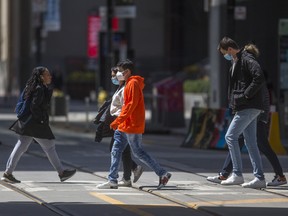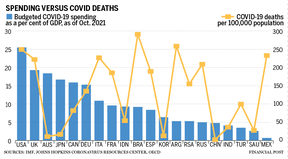Propitiating COVID With Cash
"The unique characteristics of a pandemic recession imply that fiscal policy during a pandemic should be geared much more toward helping those who are directly harmed rather than toward increasing aggregate demand more generally. That is, it should be aimed at providing social insurance rather than broad stimulus.""Although direct payments [up to $1,200 per person followed by $600 and $1,400] surely gave many households a much-needed boost at a difficult time, most of the money went to people who had not been economically harmed by the pandemic.""[If] stimulus payments that did little to help those most affected by the pandemic end up precluding spending $1 trillion on infrastructure or climate change in the next few years, the United States will have made a very bad bargain indeed."Christina D. Romer, Professor of Economics, University of California-Berkeley
 |
Those that could, did. Wealthy countries of the world, struck by the terror of the global pandemic in the face of their hospitals flooded with COVID-19 patients, workplaces reduced, small businesses failing due to closures, stricken COVID patients dying, spent wildly in the belief that if they spent widely enough and wisely enough they could 'buy' their way out of the crisis, and suffer fewer catastrophic casualties than countries unable -- due to financial constraints -- to cast treasury funding at the problem.
So in hindsight how did they fare comparatively, the big spenders and the penniless sufferers?
There was in fact, an enormous variation in spending their way around the pandemic by various countries. Some pushed their budges to highs never seen before, taking on huge debts. Other countries were far less stridently defensive and restrained their horror at what was unfolding before their very eyes. It now becomes increasingly evident that more government spending was no guarantee of more relief from the pandemic.
Governments that spent the most lavishly during the pandemic's early days counted amongst themselves the United States and New Zealand; each spending 11.5 percent of GDP, with Canada following at 10.1 percent. Four of five biggest spenders were wealthy, English-speaking countries. As an example, the spending indulged in by the government of Canada was over double that of other countries such as France, Spain and Italy.
It appears that the size of the national health crisis did not determine the size of the economic response; no evidence exists that countries with high COVID-19 mortality rates spent more on the pandemic than did countries with lower rates of population death -- or vice versa. "Countries in 2020 appear to have been constrained in their fiscal choices ... by their ability to borrow", explained Ms.Romer in a case study. Wild borrowing is what enabled these countries to spend as much as they could.
Those countries of the OECD with poor bond rating scores like Italy and Greece were forced by circumstances to spend substantially less than did countries with higher credit ratings. Canada began the pandemic with a top-rated AAA credit rating, representing one of the countries that borrowed and borrowed as though they would never be faced with a future invoice for repayment. In the process its credit rating descended in reflection of its vast borrowing amounts.
Canada was the fifth largest spender according to the IMF, its pandemic bill totalling a whopping 15.9 percent of GDP, but the prize goes to the United States, at a stratospheric 25.4 percent. Once more, four of the top five spots place wealthy English speaking countries in an overspending clique. Mexico, on the other hand, sits at the bottom with 0.7 percent of GDP spent on programs for COVID-19.
There seems to be no relationship that stands out between spending an historically immense wealth of borrowed money and a better health or economic outcome getting through the pandemic. The U.S. high COVID-19 mortality rate linked to its high spending reflects a poor return on investment with a death toll of 251 per 100,000 population, slightly worse than Mexico's 234 per 100,000 -- bearing in mind that Mexico spent negligibly on COVID-19.
The most efficient country leading the pack in outcome is South Korea with a mortality rate of 11 per 100,000 representing a fraction of what even Canada at 81 deaths per 100,000 experienced. Countries that spent less than average on COVID-19 policies, locking down less aggressively, were those that spent less than the average. South Korea stands out for its combination of below-average spending and above-average economic results, along with fewer population deaths.

Labels: COVID-19, Economic Recovery, Economist Study, Mortality Rates, National GDP to COVID Spending

0 Comments:
Post a Comment
<< Home